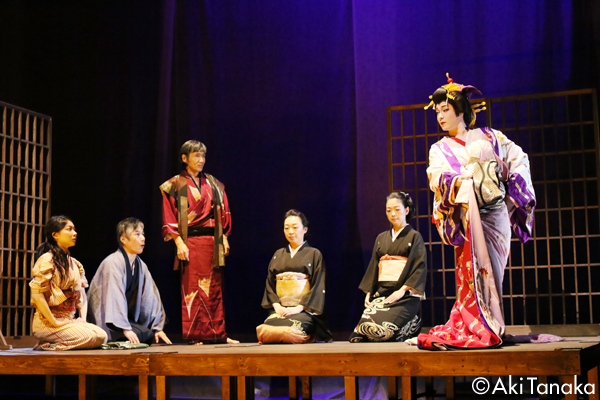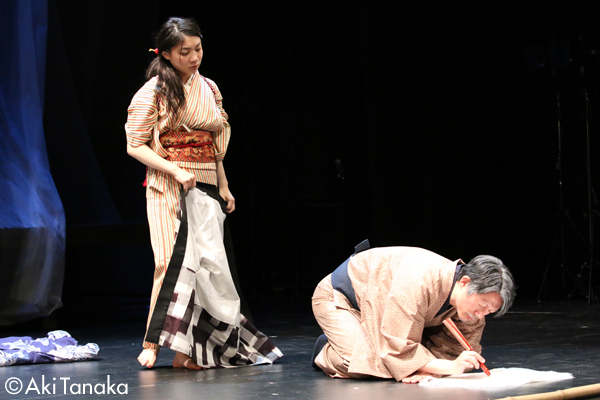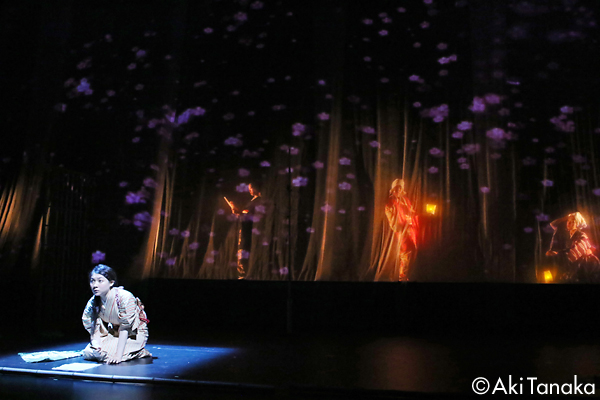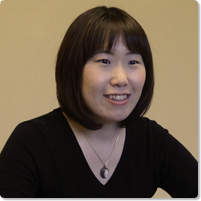


Tegamiza 13th production
San-san
(Nov. 3 – 13, 2016 at Za-Koenji 1) Photos: Aki Tanaka
Data
:
Premiere: 2016
Cast: 12 (8 men, 4 women)
San-san (Brilliance)

Born in Tokyo, 1977. Osada graduated from the School of Humanities and Social Sciences of Waseda University with a major in Literary Arts. From 1996, she began writing stage scripts and song lyrics for musicals, and from 2007, she began taking seminars in play writing given by the Japan Playwrights Association. The next year, she became a student of Hisashi Inoue, associated with the same seminar series. In 2009, she started the theater group Tegamiza as its playwright, and that year the group staged their first performances and on commission from other producers. Her works have won high acclaim writing skills defined by finely chosen words that express the subtleties of the heart and skillfully crafted storylines with great scale. In 2015, Osada’s Tegamiza production Chi wo Wataru Fune – (A Boat Crosshing the Land – 1945 / Attic Museum and the Documenters (restaged with direction by Takuya Senda) won the New Artist Award of the 70th Agency for Cultural Affairs’ Arts Awards in the Drama division, and in 2016 her Gurupuru Baru production of Osada’s play Mikan and Yutsu – Ibaraki Noriko Ibun (direction by Makino Nozomi) won the 19th Tsuruya Nanboku Drama Award. In 2018, Osada won the Individual Award of the Kinokuniya Drama Awards for the Seinenza production of her play Sajin no Nike (direction by Keiko Miyata), the Tegamiza production of Umigoe no Hanatachi (direction by Kino Hana) and the Parco Produce production of The Sea of Fertility (direction by Max Webster).
In recent years, Osada has expander her activities writing works for the New Buyo theater SOU (direction by Fujima Rankoh), for the second Ichikawa Ebizo personal production “ABKAI 2014”, for the Bungakuza Atelier Kai production Fuyu no Rakuen (direction by Hitoshi Uyama) and Yosokyoku-shu (direction by Eriko Ogawa), the Hyogo Prefectural Piccollo Gekidan production of Toyo Gokuraku Kishitsu (direction by Satoshi Uemura), the Gekidan Mingei production SOETSU – Kara Kuni no Shiroki Taiyo (direction by Ikumi Tanno), Hyakuki Opera Rashomon (direction by Inbal Pinto and Avshalom Pollak) among others.
Tegamiza website:
http://tegamiza.net/



Tegamiza 13th production
San-san
(Nov. 3 – 13, 2016 at Za-Koenji 1) Photos: Aki Tanaka
Data
:
Premiere: 2016
Cast: 12 (8 men, 4 women)
Katsushika Hokusai’s daughter, O-ei (Katsushika Oui), has been teaching herself to paint by what she sees around her since she was a child. One of Hokusai’s apprentices, the painter Minamizawa Tomei, has finally won her hand in marriage, but even on their first night as man and wife O-ei keeps painting late into the night by candlelight.
Suddenly the fire bell is heard, signaling that a fire has broken out in the neighborhood. O-ei takes her brush and rushes out to see the fire. There she finds the painter Ikeda Zenjiro (artist name: Keisai Eisen) who is a live-in apprentice at Hokusai’s home. The two begin to talk about what colors they would use to paint the fire they watch.
It is early summer in the year 1823. At his studio in the Honjo district of Edo, Hokusai had O-ei taking care of not only his own daily needs but also assisting his apprentices in their work. Forgetting that he has married her off already, Hokusai calls out for O-ei. When she isn’t there, Hokusai doesn’t even know where the things he needs are. Hokusai’s wife had told him time and again that happiness for a woman lies in marriage and that since O-ei is a woman he should convince her to give up the idea of being a painter.
Onto the scene comes the print publisher Nishimuraya Yohachi (Eijudo) with a proposal that he wants to publish a “pillow book” (book of erotic art prints) based on paintings by Hokusai, Zenjiro and more of the best painters of the day. O-ei happens to be present and says that she wants some of her own paintings to be included in the book too, but Hokusai scolds her and sends her off, saying that her paintings are second-rate illustrations because the figures don’t come to life.
On a bridge, O-ei meets one of Hokusai’s senior apprentices, Totoya Hokkei and begins to confide to him her doubts about herself as a painter. Hokkei advises her to be ambitious, learn what she can from those around her and find what she really wants to paint.
When O-ei returns to the house that she has married into, she finds her husband Tomei and it appears as if he has just been with a streetwalker. He has lost confidence in his talent as a painter and says to her in a gruff voice that the glimpses of the master Hokusai that her presence conjures up irritate him to no end. Seeing in her husband a shared weakness, O-ei is about to show compassion when he suddenly announces that he intends to divorce her.
Wandering the streets in the middle of the night, O-ei meets nighttime noodle vendors pulling their [wheeled] outdoor noodle stand while calling out for customers. The man says that because of his impotence he can’t satisfy his wife in the prime of her womanhood. The wife says that doesn’t bother her. The man tells his wife to let a passing man have her, and as he watches her being had in the roadside bamboo grove, O-ei changes the man’s face for that of her husband in her mind and paints an erotic painting of such a sad couple finding consummation.
Arriving at the Hokusai studio in the morning, O-ei shows the erotic painting to Hokusai and Zenjiro. Hokusai spontaneously picks up a brush and begins to paint, and Zenjiro, now recognizing O-ei as his rival, decides to leave his apprenticeship in Hokusai’s studio.
One day, a request arrives from the German doctor and naturalist Philipp Franz von Siebold, who is staying in the Dutch trading colony of Dejima in Nagasaki, for Hokusai and his studio to paint 100 pictures of “Life in Edo” in the Western painting style. Hokusai decides to let O-ei do some of the paintings as a full member [apprentice] of the studio, and he tells her to “paint the women” of Edo.
O-ei goes to the red light district of Yoshiwara to paint a portrait of the beautiful high-ranking
oiran
courtesan Kirisato. Kirisato has never permitted anyone to paint her portrait before. But, since she would soon be leaving Yoshiwara because the owner of the brothel she was indentured to had decided to end her commitment as a geisha and send her to be married, Kirisato decided that she would allow O-ei, being as she was a woman, paint her portrait. When Kirisato meets O-ei she says that she wants to show her the true figure of a geisha. This “true figure” was the figure of a senior geisha named Yugiri, who had been Kirisato’s secret love and reason for living and was now on her deathbed dying of venereal disease, and the figure of the mourning Kirisato who was now being released from the bondage of her geisha contract and forced to leave the dying Yugiri behind. O-ei is disheartened by the knowledge that she is unable to paint such a figure as she has just seen with her still unworthy painterly skills, but in a gesture of gratitude for having been witness to her “true figure,” Kirisato gives O-ei her ornamental hairpin.
A message arrives at Hokusai’s studio that Zenjiro, who has taken bad ways since leaving his apprenticeship at the studio, has been arrested for a criminal offense involving gambling. O-ei is sent to bail him out, and after she scolds him to not sell himself so cheaply and return to his true path as a painter, she gives him a kiss. But, Zenjiro goes off with a courtesan he has been patronizing named Otaki. It is only now that O-ei realizes her love for Zenjiro.
The paintings that Siebold has ordered are finished. When the painter Kawahara Keiga who has been working for Siebold at Dejima comes to collect them, his eyes stop on one particular painting and he says, “There is still some awkwardness in it, but whoever painted it has absorbed the Western painting style and taken it in a new direction that becomes a strength. It was one of O-ei’s paintings.
Empowered by Kawahara’s words, O-ei applies herself to her painting with new resolve. Motivated by the lives of the women she meets and secretly harboring her love for Zenjiro, she continues to paint portraits of beautiful women.
At the twilight hour, when the day’s painting work is coming to an end, Zenjiro comes by the studio to bid farewell, saying that he intends to open up a brothel with Otaki and other prostitutes. As Zenjiro is about to leave, O-ei gets up the courage to confess her love for him, saying, “I want you.” Even though Zenjiro’s first reply is, “But you belong to Hokusai,” he decides to accept her love and the two take their brushes and leave the studio together.
The season has changed, and it is now July. Seeing O-ei’s paintings of beauties, Hokusai decides to give her an artist’s name, Oui, as recognition of her independence as a painter and artist in her own right. O-ei looks up at the first towering thunderhead of summer. She takes out paper and a brush to begin a new kind of painting.
Related Tags